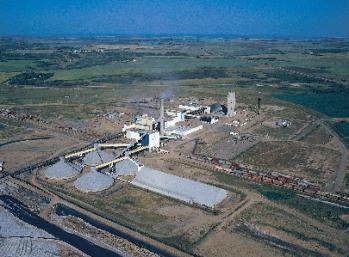
Potash production is a major Saskatchewan industry, which has played a significant role in the economy for over 40 years. The ten producing mines in the province are among the largest and most modern in the world. Underground potash deposits were laid down by evaporation in an ancient inland sea; three major layers of potash are separated by layers of salt. Potash deposits are located from the Alberta border west of Saskatoon, through much of the central portion of the province, to the southeast corner and beyond. Much of Saskatchewan's deposits are 3,000-3,500 feet underground; but they are deeper further south, beyond conventional shaft and mining techniques. Operations are located where potash-bearing ore is 7-11 feet thick. Most potash in Saskatchewan is in the form of potassium chloride (KCl). Recoverable reserves are well over 100 billion tons. Of the potash produced, 95% is used for fertilizer, and the remainder for industrial purposes. Potash was first found in Saskatchewan in 1942 during oil drilling. Further discoveries in the 1940s and early 1950s confirmed enormous deposits. However, three projects in the 1950s encountered formidable water problems during shaft sinking, which hampered development.
Production commenced in 1962 when water problems were overcome at the International Minerals and Chemical (IMC) mine near Esterhazy; the Potash Company of America (PCA) then rehabilitated its flooded mine. A surge of development by other companies resulted in twelve companies opening ten mines by 1970. Industry expansion exceeded market growth, producing a crisis that threatened some mines with closure. Having earlier pressed for rapid development, the government was then forced to intervene and introduce a “rationing-pricing” plan, which saved the industry from disaster. As the industry recovered, a new NDP government pressed for increased provincial revenues and wanted to participate actively in plant expansions. Industry resistance grew, especially after a major taxation increase. Eventually, most companies stopped paying provincial levies, refused to expand capacity, launched court actions to thwart government initiatives, and stopped supplying standard production information. Federal actions further complicated matters. The government responded by announcing on November 12, 1975, that it would seek powers to acquire, by expropriation if necessary, ownership of part or all of the potash industry.
From 1975 until 1982 a Crown corporation, Potash Corporation of Saskatchewan (PCS), acquired through negotiation ownership of four mines and the producing property of another operation mined under contract. These acquisitions, together with plant expansions, resulted in PCS owning 40% of Saskatchewan's productive capacity. PCS, a very profitable operation which was aided by good marketing conditions, played an active role in international industry affairs and contributed materially to a growing Saskatchewan economy. It also planned on further expansion and diversification. At the same time, negotiations resumed between the government and potash producers, including PCS, on royalties and other provincial payments. The agreement reached brought the government significantly higher revenues while ensuring potash producers a reasonable rate of return. Potash markets became more difficult when the government changed in 1982: PCS expansions continued without an accompanying marketing strategy; and incurred heavy losses. By 1988, PCS was privatized as part of a broader privatization program; the process was completed in 1991, just before another change in government. Studies concluded that the province had lost a significant amount of value in the process.
The privatized PCS Inc. has since acquired another mine and expanded into nitrogen and phosphorus production, becoming a diversified fertilizer producer. It is now a very profitable operation, potash still providing its main strength. International Minerals and Chemicals (IMC) has acquired two other mines, bringing its total ownership to four. Cargill now has a major stake in IMC. Agrium, formerly Cominco, is the only other potash operator in the province. Thus, the industry has been effectively rationalized into three firms, each with diversified fertilizer operations. The ten mines completed by 1970 still constitute today's capacity. A small potassium sulphate (K2SO4) operation near Wynyard combines standard KC1 with Mg2SO4 from Quill Lake to produce K2SO4, used for specialty fertilizers. Three mines are located near Esterhazy and Rocanville, one at Belle Plaine between Moose Jaw and Regina, while the other six are between Lanigan and the Saskatoon area. Production in the last twenty years totalled 230 million tonnes of KCl sold for $22.7 billion. Provincial direct revenues during this time were over $2 billion. Direct employment has been stable near 3,000, plus associated activities. Capital spending over the last twenty years totalled $1.6 billion. While potash has made an important contribution to the Saskatchewan economy, it is debatable whether it has achieved its full potential for the province.
John Burton